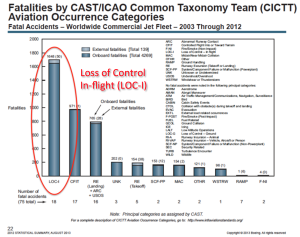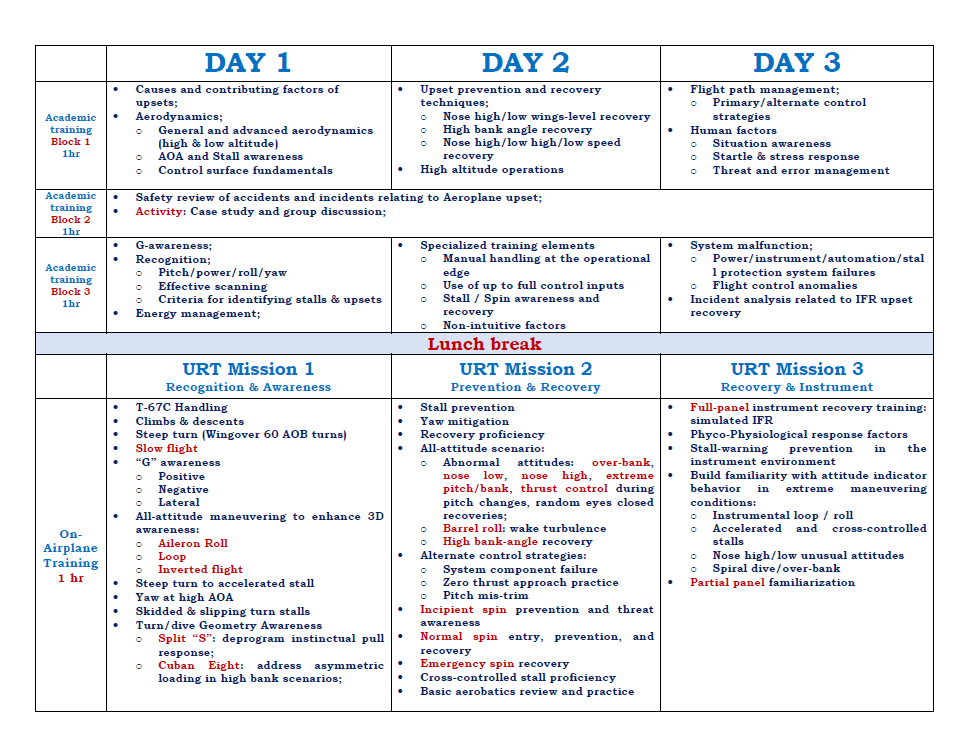Loss Of Control In-flight, how serious is the problem?
Due to a lack of all-attitude recognition, avoidance and recovery training, LOC-I (Loss Of Control Inflight) has been, and continues to be, established as the most lethal threat to pilots of any fixed wing airplane…
In a report issued by Boeing Company in July 2013, LOC-I represents the most severe cause factor in commercial aviation over the past 10 years, resulting in the most crash-related fatalities from 2003 through 2012.
An accident caused by the loss of control of an aircraft in-flight is very rare, but over the last decade these accidents have resulted in more fatalities in scheduled commercial operations than any other type, including runway incursions, runway excursions and controlled flight into terrain. It’s because of its association with high fatalities that LOC-I is now the number one issue in aviation today.
We can use the lessons learned to relegate upsets to hangar tales rather than breaking news!
ko
Upset Prevention and Recovery Training, what needs to be taught?
Aviation trains pilots and controllers for what the airplane is supposed to do, not for what it’s NOT supposed to do, while upsets take the airplane out to or beyond its operational limits. The pilots may be required to max-perform the airplane without jeopardizing structural limits. The goal is to increase the ability of pilots to recognize and avoid situations that lead to airplane upsets and to improve their ability to recover control, utilizing the aircraft’s full flight envelope. UPRT improves manual handling skills for avoidance of, and recovery from, the edges of the flight envelope. It helps the pilots to know how the airplane responds to inputs across flight regimes.
For instance, flight control inputs become less effective when the airplane is at or near its critical AOA or stalled. The tendency is for pilots not to use full control authority because they rarely are required to do so in normal operations. Pilots MUST overcome this habit when recovering from severe upsets.
What’s the missing ingredient in the current Flight Simulation Training Device program?
Current FSTDs have limitations that render them incapable of providing the COMPLETE EXPOSURE to conditions synonymous with preventing or recovering from a LOC-I event.
Limitations in FSTD motion cueing and the reduced emotional response create boundaries that prevent pilots from experiencing the full range of aeroplane attitude, load factors and behaviour that can be present during an actual flight.
The on-aeroplane training provides physiological and psychological exposure geared toward upset prevention and recovery which creates a frame of reference that can be transferred to the FSTD environment later in their training.
Is UPRT program the same thing as aerobatic training?
UPRT is NOT synonymous with aerobatic flight training. Giving pilots the correct gut responses to upsets is more complicated than exposure to aerobatics.
From the human factors aspect, aerobatics does not specifically address the element of “startle”. Nor does it necessarily provide the best medium to develop the full spectrum of analytical reasoning skills required to rapidly and accurately determine the course of recovery action during periods of high stress. In high threat situations such as airplane upsets, mental ability can be severely diminished by fear. Practical exposure under controlled conditions is essential to complement the theoretical training and improve the pilot’s ability to manage threatening events.
Why choose Aero Tigre’s UPRT program?
Highly-qualified instructor:
The UPRT on-aeroplane environment may be beyond that which is experienced during normal training operations. The unpredictable nature of trainee inputs, reactions, and behaviour requires fluency in response to a wide variety of potential situations requiring a time-constrained and accurate response of the flight instructor.
With more than 15,000 hours total flight time and a life-long passion for aviation, the president and chief instructor of Aero Tigre Michel Hamel has the perfect combination of sound theoretical and operational knowledge and extensive experience required to deliver our UPRT programme. Michel Hamel’s Canadian Air Force high-performance fighter-jet background (1340 hours, F-18, F-5) and training experience (standard training officer, aerobatic instructor, check pilot) gave him comprehensive understanding of upsets and usual attitude recovery techniques, while his vast experience as commercial airline pilot (over 10,000 hours’ PIC time, A-310, A-300/600, B-727, B-747-400) contributed to his insights into the specialized technologically advanced aircraft and transport category flight operations. He’s a Class 1 aerobatic instructor and Aero Tigre is a Transport Canada approved aerobatic instructing school.
Training aircraft capability:
UPRT on-aeroplane training program have a strict requirement on the type of training aircraft, which can provide the complete exposure to conditions synonymous with preventing or recovery from a LOC-I event, meanwhile allow adequate margins of safety for the trainees.
With its state-of-the-art, light-weight and very strong airframe, Slingsby Firefly T-67C has a maximum airspeed of 333 km/h, and can withstand a punishing +6/-3 Gs with the flick of the wrist. Agile, sensitive and powerful, it is the perfect choice for UPRT on-aeroplane training program. Its side-by-side seats and two sets of stick and rudder make it more convenient for communications between the instructor and trainees.
Aero Tigre’s chief instructor Michel Hamel first flew this British build high-performance aerobatic aircraft when he worked for Bombardier Canadair as Instructor Pilot, Check Pilot and Aerobatic Instructor, training different Air Force military squadrons. Slingsby Firefly T-67C served as the official training aircraft of Canadian Air Force at that time.
Comprehensive UPRT programme:
Strictly following the International Civil Aviation Organization (ICAO) ’s latest documents and “Manual On Aeroplane Upset Prevention and Recovery Training” (Doc 10011), Aero Tigre’s 3 Day 3 URT missions training programme provides an integrated comprehensive approach to deliver the UPRT components of academic training and practical training in 6 hours of ground school and 3 hours of on-aeroplane missions to satisfy 3 distinct areas/objectives: heightened awareness, effective avoidance and effective and timely recovery. The goal is to provide pilots with the necessary knowledge, skills and attitudes to reduce the probability of an upset encounter and to maximize their ability to recover from such an event and to equip them with the ability to maintain and, if necessary, regain aeroplane flight path control in all normal and abnormal (recoverable) situations.
Ground school:
Complying with the academic training standards of the latest ICAO Manual on Aeroplane Upset Prevention & Recovery Training issued in March 2014, and closely-related and backed-up by real world scenarios and incidents analysis, Aero Tigre’s UPRT ground school is consist of three stand-alone yet correlated blocks focusing on different aspect of UPRT training:
Block 1: Academic training: designed to equip pilots with the knowledge and awareness needed to understand the threats to safe flight and employment of mitigating strategies;
Block 2: Real world connections: the evidence-based perspective helps the pilots to build a bridge between the theoretical knowledge and the real world application to facilitate the positive transfer of mindsets and skillsets and allows the pilots to mentally integrate the areas of threat. By analyzing and discussion of a vast range of LOC-I accidents and incident, the pilots can relate to, and more important, practically apply their knowledge.
Block 3: Practical skills: corresponding to each day’s UPRT on-aircraft training mission, the practical training block is designed to equip pilots with the required skill sets to effectively employ upset avoidance strategies and, when necessary, effectively recover the aeroplane to the originally intended flight path.
UPRT flight missions:
To provide experience and confidence that cannot be fully acquired in the simulated environment alone to compensate the gap in pilots’ understanding and proficiency when confronted with actual upset, and to dramatically enhance manual handling skills and increased awareness of the results of flight path deviations. Aero Tigre’s on-aeroplane mission also emphasize the introduction of general principles of understanding and techniques which may be applied to a wide range of aeroplanes and are NOT in conflict with commercial air transport aeroplane recovery techniques. With respecting the need to ensure adequate safety margins, our UPRT flight missions will strive to include the element of “unexpectedness” that pilots will experience in a real world application, under the close supervision and direction of our highly-qualified flight instructor.
Target Audience
No matter how rare an accident caused by LOC-I happens, for everyone involved it’s 100% of loss. As long as you have private pilot license and the DESIRE to become a safer and better pilot, Aero Tigre’s UPRT programme is for you!
With our flexible schedule, and proximity to Montreal (30 minutes’ drive) and to the aerobatic training zone (5 minutes’ flight), we can cater to the varied and specialized needs of Airlines and training centers, corporate and business, flight schools, or owners and operators.
Join us to promote the safety in the sky!


